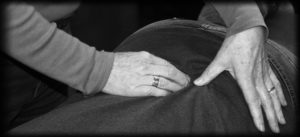amatsu
A BRIEF HISTORY OF AMATSU
Amatsu therapy is a fairly modern amalgamation of principles of western osteopathy and massage with ancient Japanese martial systems of movement and medicine.
Amatsu principles are derived from Dr Masaaki Hatsumi and the ancient school of Ninjitsu known as Hi Chi Bu Ku Goshin Jutsu.
Translates as “The secret school of the opening flower”
The school’s ancient principles form the scrolls, called the Tatara. These principles are based on martial arts, oriental medicine, philosophy, strategy and religion dating back over 2000 years. The knowledge has been passed down through successive generations and the present day head of the Tatara is Dr Masaaki Hatsumi.
After teaching American soldiers in Japan, Dr Hatsumi noted that their large, strong build gave them a natural advantage in battle. This observation inspired him to find another martial skill where size and strength were not as important as skill, thereby making skill the advantage. His search led him to Ninjutsu.
Ninjutsu principles of stealth and deception, also used to defend oneself, are incredibly powerful healing tools. These skills are the basis of Amatsu which was subsequently brought to the West in 1995 by three therapists – Dennis Bartram, William Doolan and Christopher Roworth who had been extensively trained by Dr Hatsumi. Such were these three men’s skills, that for the first time in history, the knowledge was allowed out of Japan and they were each granted full teaching rights. Using this knowledge, together with modern research into anatomy, physiology and movement, they created Amatsu and began teaching its principles and techniques.
HOW AMATSU MAY HELP YOU
The body is designed to move freely, at will, maintaining and repairing itself as and when needed. If, for some reason, such as injury or lifestyle, it cannot do that, it will adapt and move in a modified way in order to perform the tasks that we ask of it. These adaptations can sometimes build up until there is no further ‘room for manoevre’ and our body cannot bounce back to its healthy state. Often this is the point where we feel enough pain or discomfort to seek help.
Amatsu, using the ninjutsu principles, is a very gentle therapy where the client is barely aware of the powerful and far reaching techniques that the practitioner is using to re-balance their body. As the subtle corrections are working WITH the body without FORCE, the body easily accepts the changes which allows it to ‘unwind’ some of those painful adaptations and return to equilibrium. This technique of working WITH the body works on many levels as a holistic therapy.

AN AMATSU BALANCE
As Amatsu is a holistic therapy, we need to know how your life impacts your body, therefore your medical details, current medications and lifestyle need to be taken into account to ensure a safe and appropriate balance.
Each balance begins with a General Listening to determine the area of the body which is causing imbalance. This is then followed by further assessments and local listening to pinpoint the problem area which is most likely to be causing restriction. Using very gentle techniques, the restriction is released so that normal mobility can be restored.
The corrections may sometimes be quite distant from the problem but a chain reaction of corrections is quite possible due to the interconnected nature of our body. Particular attention is paid to the balance of the pelvis and spine and the head’s position on the top of the spine. If these are balanced it will ensure a healthy nerve supply and therefore optimum health as the nervous system is the main controller of our body.
There may be visceral (internal organs) restrictions which affect the musculoskeletal system or the other way around, where injured muscles, ligaments or bones are causing organ restriction.
Using the many tools of Amatsu, most of these problems can be addressed to restore balance to the body, easing pain and enabling increased mobility.
STRUCTURAL BALANCE
Restoring structural balance allows the body to move with ease, performing tasks in a comfortable and natural way. A balanced structure allows our joints to function as they were designed to do – moving smoothly without strain. The balanced structure easily supports the internal organs, allowing them to maintain optimum performance too.
An example of how imbalance can cause further complications:
A sprained ankle is pretty painful, so after a few days of rest we attempt to walk without placing any weight on the injured ankle. That’s fine as our bodies can adapt around the injured ankle for a while. These adaptations will be far-reaching as the body’s weight will be channeled to the opposite leg. The knee will be under pressure dealing with more weight at a slightly different angle. The pelvis will have to tilt slightly to support the good leg, which is now working extra hard. As the spine is connected to the pelvis, it too, will have to adapt. Our eyes need to maintain a level vision so that our brain can know where we are in space, therefore our head, at the top of the spine, will tilt to accommodate this. Our internal organs, meanwhile, adapt their position to the new shape of the structure and do their best to be efficient.
This is just part of the story, but it can be seen what might happen if this situation persists or the body cannot re-balance itself because of further injury caused, possibly, by these adaptations.

VISCERAL MANIPULATION
Releasing visceral (internal organs) restrictions and restoring their motility encourages those organs to be more efficient. If an organ is restricted by disease or injury, the body will tighten up around it to protect it, possibly causing pressure on the structure and other organs. Equally, if there is injury or disease to the structure, the body will tighten up around that too and possibly restrict the organs. Listening techniques will pinpoint the priorities so that effective releases can be used to restore balance allowing structure and organs to work in harmony.
NEURAL MANIPULATION
Nerves like to be able to move freely, so that information that they are carrying is speedy and unhindered. If there is restriction, the body perceives that there’s a problem and offers us a chance to deal with it by registering pain, tingling or numbness. If it is simply a case of us moving to restore the nerve’s clear pathway it’s fine. If there is a build up of our body’s adaptations to cope with injury, we may not be able to undo the restriction so easily. This is where neural manipulation can be useful. The skills of the practitioner enable them to release the nerve’s restrictions in exactly the right way for the body.
GENERAL WELLBEING
Simply put, when the body is balanced and functioning to its optimum level, we feel great, sleep well, have more fun and can generally enjoy life. We can easily cope with life’s mental/emotional challenges and bounce back quickly from most injuries.
